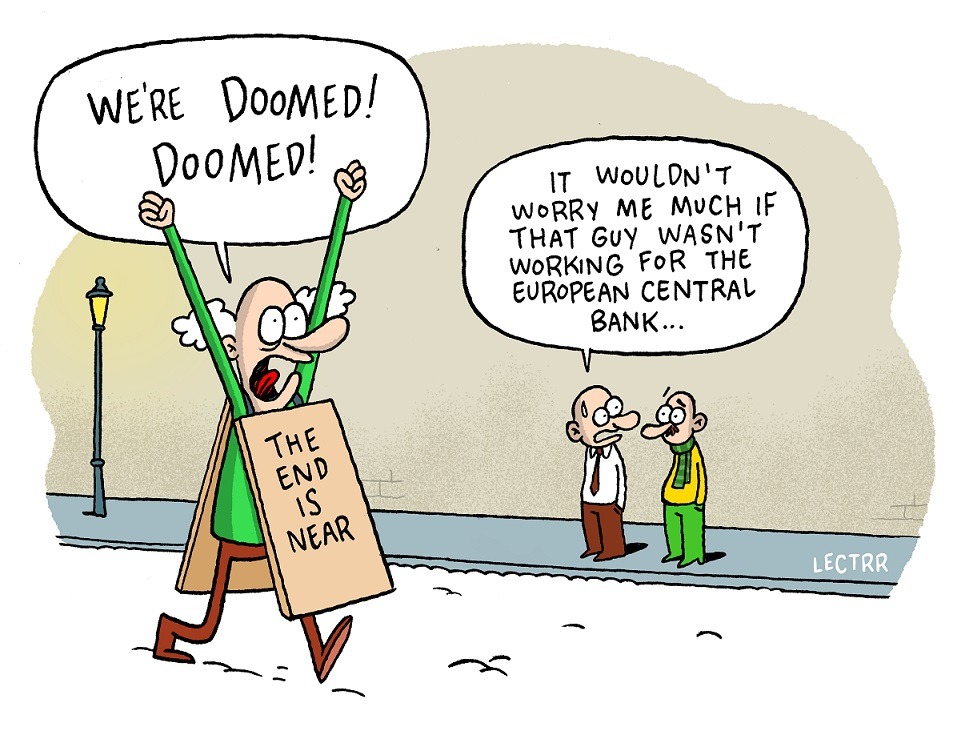The horrific Paris attacks look set to have an enduring impact on Europe in all sorts of ways, from tougher border controls to better intelligence sharing. But fortunately they are unlikely to do much harm to the economy. The Madrid bombing in 2004 and the London ones in 2005 had scarcely any economic impact. Even 9/11 caused only a blip. It seems implausible that fear of terrorism is going to deter French people from Christmas shopping, especially since they can now do so online. Few companies are likely to put investment plans on ice. And while tighter border controls and pricier insurance may harm trade, increased police and military spending is likely to boost demand.
But while the Paris attacks are unlikely to add to the Eurozone’s economic misery, the situation remains grim. Far from gathering speed, the Eurozone’s very weak recovery has again slowed. The economy grew by a mere 0.3% in the third quarter of this year.
That poor performance is particularly galling because the Eurozone is currently benefiting from several positive tailwinds. Consumers and companies are gaining from the halving of oil prices over the past 18 months. Exporters are cheering a weaker euro, whose trade-weighted exchange rate is 12% lower than 18 months ago. Governments are no longer tightening their belts: fiscal policy is now broadly neutral. And the European Central Bank (ECB) has finally embarked on quantitative easing (QE). Long-term interest rates have fallen sharply since early 2014 – the Italian government, for instance, is paying around 2.5 percentage points less to borrow for ten years. And bank lending to businesses is no longer falling, for the first time in more than three years.
Yet even with all those favourable factors, the Eurozone economy grew by just 1.6% in the year to the third quarter. Inflation has barely picked up, and the ECB recently revised down its inflation and growth forecasts. For economies struggling with huge debts, this combination of low growth and zero inflation is toxic. While unemployment is falling, it remains very high: nearly one in nine are officially out of work and many more have given up looking. And if the Eurozone economy can scarcely lift off with all these positive tailwinds, how will it cope with headwinds such as a Chinese slowdown, higher US interest rates, an emerging-markets crisis, a flare-up in Ukraine or Greece, or some other piece of bad luck?
While most Western economies are struggling to recover from the financial crisis and the ensuing balance-sheet recession, the Eurozone is doing exceptionally badly. Whereas the US economy is 11% bigger than in early 2008 and the UK’s is up by 6%, the Eurozone’s is still 0.5% smaller. Indeed, the Eurozone is doing worse even than Europe did in the 1930s. Back then, the sterling bloc, the countries that quit the Gold Standard in 1931, recovered relatively quickly, while the gold bloc, those that remained on the Gold Standard until 1936, stagnated. Eight years into the crisis, the Eurozone is faring worse than the gold bloc.
Huge attention has focused on Greece, where the situation is truly catastrophic: its government is insolvent, its economy has shrunk by more than a quarter and it is being run as a quasi-colony by Berlin and Brussels. But many other countries are in a deep hole too, including in northern Europe. Indeed, Finland’s economy has shrunk by more (7.2%) than Portugal’s (6.4%) since the crisis began, while the Netherlands (up 0.5%) is doing worse than France (up 2.5%). As for Spain, that supposed success story: its economy is still 4.6% smaller. And while Germany’s performance may look relatively good from a Eurozone perspective, it is doing less well than Britain, and much less well than Sweden, Switzerland and the US.
So while the dominant narrative in the Eurozone is that its problems lie with the legacy of excesses and a lack of reform in southern Europe, in fact the Eurozone as a whole – including Germany and northern Europe – is struggling. While some of this is due to national policy failures, much of it is due to policy and institutional failings at a Eurozone level.
The Eurozone’s weakness is partly due to longstanding supply-side problems: a lack of innovation and enterprise, cartelised product markets, ossified labour markets, rigged and subsidised land markets, a bloated and often inefficient public sector. Over the past decade, productivity growth has been feeble, much less than 1% a year almost everywhere, including Germany, which is not the success it is often portrayed as.
This lack of dynamism is in part due to a suspicion of change, aversion to taking risks and deep pessimism about the future. But it mostly reflects crony capitalism: the capture of governments by vested interests that stifle opportunity and seize the value created by others. Witness how a lack of competition in Belgium’s mobile-phone market enables companies to charge exorbitant prices for poor service, while underinvesting in new technologies.
To make matters worse, demographic decline is setting in: the Eurozone’s working-age population has been falling since 2011. Combine poor productivity with dismal demography, and the Eurozone’s potential, long-term rate of growth could be 1% a year or less.
But the Eurozone’s biggest immediate problem is a lack of demand. Growth is no longer being driven by net exports or depressed by austerity: it is driven almost entirely by consumption. And to put it simply, debtors can’t spend much, while creditors won’t spend much. That is true within countries and also across them: Germany’s current-account surplus has swollen to a vast €244 billion a year: nearly 8% of GDP. Whereas Germany’s excess savings were previously recycled to southern Europe – and unfortunately pumped into property speculation rather than productive investment – they are now being lent outside the Eurozone, draining demand within it and exporting deflation.
Investment, the bridge between today’s depressed demand and tomorrow’s expanded supply, remains more than 15% below pre-crisis levels. Both business and public investment are at historic lows as a share of GDP. Business investment is feeble because demand is weak, many companies are weighed down by high debts, and bank credit remains tight for those that want to borrow.
There’s no end to this misery in sight. The Eurozone is seven or eight years into a deleveraging crisis, and there has been scarcely any reduction in debt at all. The longer-term danger is that with poor productivity growth, demographic decline, inadequate investment, crushing debts and impaired banks, the Eurozone remains trapped in near-stagnation. That, in turn, would threaten the sustainability of public debt in many countries and the survival of the euro.
To escape from this stagnation trap, the Eurozone needs to start by tackling balance-sheet problems much more vigorously. It needs finally to clean up its banks, encourage corporate and mortgage debt restructuring, and facilitate corporate insolvency and personal bankruptcy procedures where necessary. With less debts, households would sooner be able to spend more and businesses to invest more.
Germany and other creditor countries also need to play their part in the adjustment by boosting demand. The Eurozone has created a mechanism for tackling dangerously excessive imbalances such as Germany’s vast current-account surplus: the European Commission needs to enforce the rules. For one thing, Germans deserve a pay rise: their productivity has risen since 1992 but their inflation-adjusted wages have not. This beggar-thy-neighbour policy of competitive devaluation is also beggaring Germans themselves.
Both creditor and debtor countries need to do more to boost investment. It’s absurd that Eurozone fiscal rules make no distinction between borrowing to boost bureaucrats’ pay and borrowing to invest in growth-enhancing infrastructure. One big spur to private investment would be cutting through the red tape that makes it so hard to start and grow a business in many countries.
More broadly, all governments need to reform more. Those reforms should focus on boosting productivity – not least by completing the EU’s single market in services – so that those productivity gains can pay for higher wages and increased consumption. The German model of neglecting productivity growth while bearing down on wages in a mercantilist pursuit of export competitiveness is a dead end. The way to compete with China is not to drive down wages to Chinese levels but to innovate, become more productive and move up the value chain.
Last but not least, a greying Eurozone needs more young workers. That’s why reforms to open up labour markets are so important – and why increased immigration should be welcomed.
In a normal democracy, such enduring economic failure would have forced a change of course by now. But Eurozone governments are bound together by lopsided rules and dysfunctional institutions and bullied into submission by Berlin, so the barriers to change are huge. It’s tragic.
By Philippe Legrain


